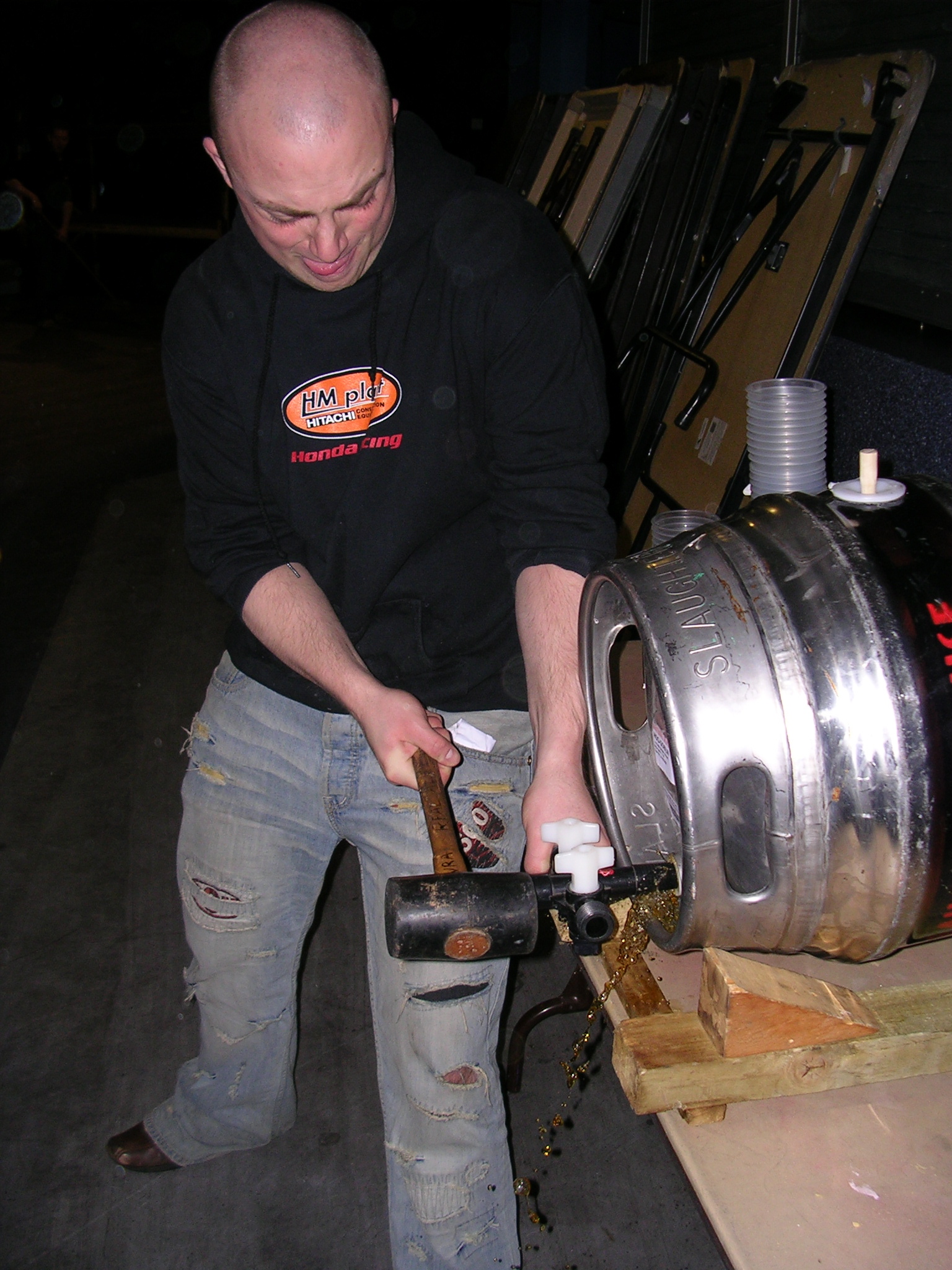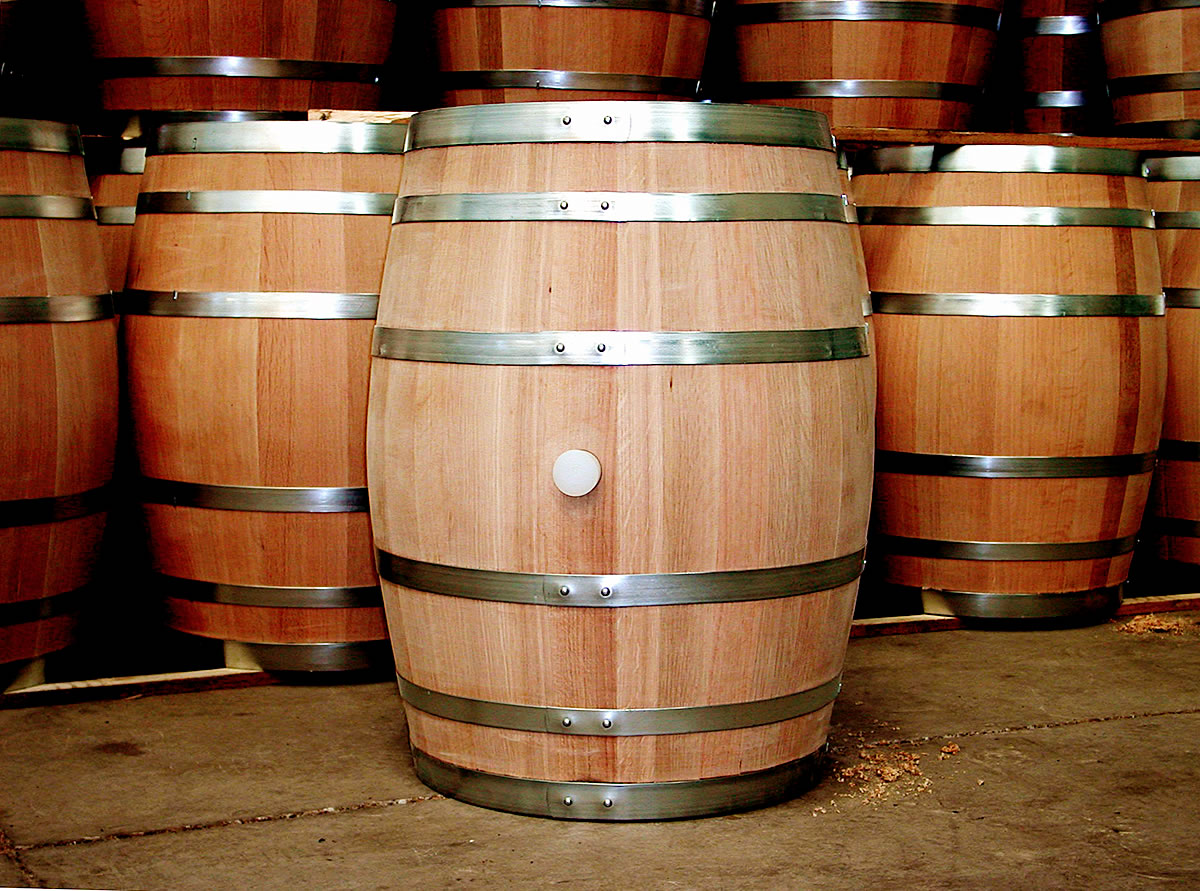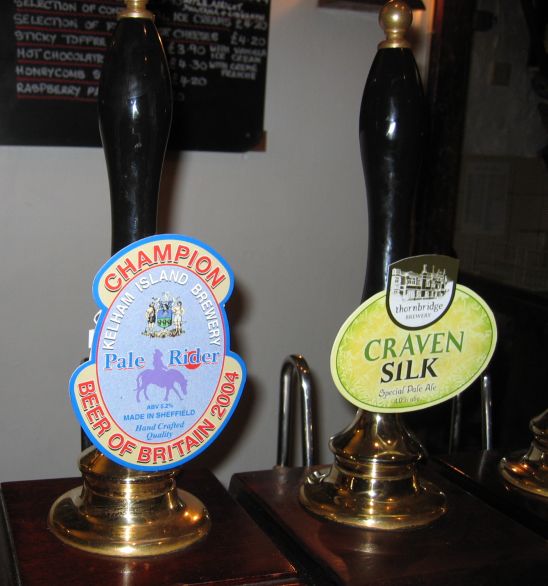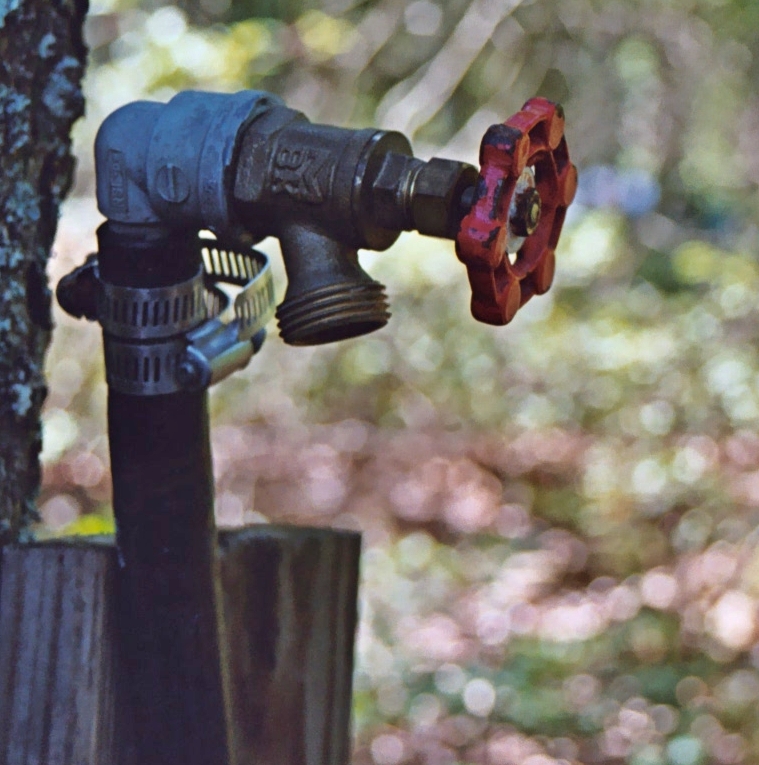|
Spile
A spile is a small wooden or metal peg used to control the flow of air into, and carbon dioxide out of, a cask of ale. Spiles can also be used to broach water from trees. Ale use Cask ale is dispensed without the addition of externally supplied gas. That it is served "flat" with no bubbles at all is, however, a misconception. Properly conditioned cask ale will have enough dissolved carbon dioxide to produce bubbles of carbon dioxide. This has been generated by the natural action of the yeast living in the beer while it is stored and transported. In fact, the yeast can produce more carbon dioxide than is required, and it is for this reason that the cask is vented through the hole in the shive. When it is first delivered to the place where beer will be poured from it or where it will be connected to the beer engine, the cask is sealed. It has a keystone (where the tap will be driven in) and a shive (through which it was filled). Once it has been laid down in the location at which ... [...More Info...] [...Related Items...] OR: [Wikipedia] [Google] [Baidu] |
Shive
{{Refimprove, date=November 2009 A shive is a wooden or plastic fitting used in ale casks. It is found on the curved side of the cask, arranged so that when the cask is on its side and the keystone is at the lowest part of the rim, the shive will be the highest point of the cask. The hole in that part of the cask is used for two purposes. Firstly, it is used for cleaning out and then refilling the cask, which requires a large hole. Once the cask arrives at its destination, the hole is used to control the amount of carbon dioxide present in the container, which requires a small hole. The shive is effectively an adaptor that reconciles these conflicting requirements. It is a wooden disk, larger than a keystone, that fits in the hole in the cask and has a smaller hole in its centre. For washing and filling, the old shive is removed using a chisel or a special tool, revealing a hole around 3 inches (7.5 cm) across. Once the cask has been filled and fined, a new shive is hammer ... [...More Info...] [...Related Items...] OR: [Wikipedia] [Google] [Baidu] |
Keystone (cask)
A keystone is a small wooden or plastic fitting used in ale casks. For some years wooden casks have been effectively obsolete, with the majority now being aluminium or stainless steel, and a few sturdy plastic ones beginning to appear. Nevertheless, the standard tap is still designed to be hammered into yielding material, punching a hole as it goes. All modern casks, even the few wooden ones still in use, use a replaceable keystone to accept the tap. Background The bung-hole of the cask is on one of the circular faces, near the rim. When the cask is in service, it is laid on its side with the bunghole at the lowest point on the circumference. The keystone is a small thick wooden or plastic disk inserted into the bunghole which completely seals the cask until it is needed. The center of the keystone is deliberately weakened, this area may be marked or unmarked and is called the tut. In the plastic variety it is much thinner than the surrounding material; if made of wood it is par ... [...More Info...] [...Related Items...] OR: [Wikipedia] [Google] [Baidu] |
Cask
A barrel or cask is a hollow cylindrical container with a bulging center, longer than it is wide. They are traditionally made of wooden staves and bound by wooden or metal hoops. The word vat is often used for large containers for liquids, usually alcoholic beverages; a small barrel or cask is known as a keg. Modern wooden barrels for wine-making are made of French common oak (''Quercus robur''), white oak (''Quercus petraea''), American white oak (''Quercus alba''), more exotic is Mizunara Oak all typically have standard sizes: Recently Oregon Oak (Quercus Garryana) has been used. *"Bordeaux type" , *"Burgundy type" and *"Cognac type" . Modern barrels and casks can also be made of aluminum, stainless steel, and different types of plastic, such as HDPE. Someone who makes barrels is called a "barrel maker" or cooper (coopers also make buckets, vats, tubs, butter churns, hogsheads, firkins, kegs, kilderkins, tierces, rundlets, puncheons, pipes, tuns, butts, pins, tr ... [...More Info...] [...Related Items...] OR: [Wikipedia] [Google] [Baidu] |
Beer Engine
A beer engine is a device for pumping beer from a cask, usually located in a Public house, pub's cellar. The beer engine was invented by John Lofting, a Dutch inventor, merchant and manufacturer who moved from Amsterdam to London in about 1688 and patented a number of inventions including a fire hose and engine for extinguishing fires and a thimble knurling machine. ''The London Gazette'' of 17 March 1691 stated "the patentee hath also projected a very useful engine for starting of beers and other liquors which will deliver from 20 to 30 barrels an hour which are completely fixed with brass joints and screws at reasonable rates." The locksmith and Hydraulics, hydraulic engineer Joseph Bramah developed beer pumping further in 1797. The beer engine is normally manually operated, although electrically powered and gas powered pumps are occasionally used; when manually powered, the term ''handpump'' is often used to refer to both the pump and the associated handle. The beer engine i ... [...More Info...] [...Related Items...] OR: [Wikipedia] [Google] [Baidu] |
Wood
Wood is a porous and fibrous structural tissue found in the stems and roots of trees and other woody plants. It is an organic materiala natural composite of cellulose fibers that are strong in tension and embedded in a matrix of lignin that resists compression. Wood is sometimes defined as only the secondary xylem in the stems of trees, or it is defined more broadly to include the same type of tissue elsewhere such as in the roots of trees or shrubs. In a living tree it performs a support function, enabling woody plants to grow large or to stand up by themselves. It also conveys water and nutrients between the leaves, other growing tissues, and the roots. Wood may also refer to other plant materials with comparable properties, and to material engineered from wood, or woodchips or fiber. Wood has been used for thousands of years for fuel, as a construction material, for making tools and weapons, furniture and paper. More recently it emerged as a feedstock for the ... [...More Info...] [...Related Items...] OR: [Wikipedia] [Google] [Baidu] |
Toddy Palm
Toddy palm is a common name for several species of palms used to produce palm wine, palm sugar and jaggery. Species so used and named include: *'' Arenga pinnata'', the areng palm *'' Borassus flabellifer'', the palmyra palm *'' Caryota'', the fishtail palms *'' Cocos nucifera'', the coconut *'' Nypa fruticans'', the nipa palm See also *Sugar palm Sugar palm is a common name for several species of palms used to produce sugar. :Species used include: *''Arenga pinnata'' (syn. ''A. saccharifera'') *''Borassus flabellifer'' *''Caryota'' :*'' Caryota urens'' *''Cocos nucifera'' See also *Toddy ... {{Plant common name Fermented drinks Edible palms Tree tapping Non-timber forest products ... [...More Info...] [...Related Items...] OR: [Wikipedia] [Google] [Baidu] |
Preservative
A preservative is a substance or a chemical that is added to products such as food products, beverages, pharmaceutical drugs, paints, biological samples, cosmetics, wood, and many other products to prevent decomposition by microbial growth or by undesirable chemical changes. In general, preservation is implemented in two modes, chemical and physical. Chemical preservation entails adding chemical compounds to the product. Physical preservation entails processes such as refrigeration or drying.Erich Lück and Gert-Wolfhard von Rymon Lipinski "Foods, 3. Food Additives" in ''Ullmann's Encyclopedia of Industrial Chemistry'', 2002, Wiley-VCH, Weinheim. Preservative food additives reduce the risk of foodborne infections, decrease microbial spoilage, and preserve fresh attributes and nutritional quality. Some physical techniques for food preservation include dehydration, UV-C radiation, freeze-drying, and refrigeration. Chemical preservation and physical preservation techniques are ... [...More Info...] [...Related Items...] OR: [Wikipedia] [Google] [Baidu] |
Alcohol (drug)
Alcohol, sometimes referred to by the chemical name ''ethanol'', is a depressant drug that is the active ingredient in drinks such as beer, wine, and distilled spirits (hard liquor). It is one of the oldest and most commonly consumed recreational drugs, causing the characteristic effects of alcohol intoxication ("drunkenness"). Among other effects, alcohol produces happiness and euphoria, decreased anxiety, increased sociability, sedation, impairment of cognitive, memory, motor, and sensory function, and generalized depression of central nervous system (CNS) function. Ethanol is only one of several types of alcohol, but it is the only type of alcohol that is found in alcoholic beverages or commonly used for recreational purposes; other alcohols such as methanol and isopropyl alcohol are significantly more toxic. A mild, brief exposure to isopropanol, being only moderately more toxic than ethanol, is unlikely to cause any serious harm. Methanol, being profoundly more t ... [...More Info...] [...Related Items...] OR: [Wikipedia] [Google] [Baidu] |
Flocculation
Flocculation, in the field of chemistry, is a process by which colloidal particles come out of suspension to sediment under the form of floc or flake, either spontaneously or due to the addition of a clarifying agent. The action differs from precipitation in that, prior to flocculation, colloids are merely suspended, under the form of a stable dispersion (where the internal phase (solid) is dispersed throughout the external phase (fluid) through mechanical agitation) and are not truly dissolved in solution. Coagulation and flocculation are important processes in water treatment with coagulation aimed to destabilize and aggregate particles through chemical interactions between the coagulant and colloids, and flocculation to sediment the destabilized particles by causing their aggregation into floc. Term definition According to the IUPAC definition, flocculation is "a process of contact and adhesion whereby the particles of a dispersion form larger-size clusters". Floccu ... [...More Info...] [...Related Items...] OR: [Wikipedia] [Google] [Baidu] |
Finings
Finings are substances that are usually added at or near the completion of the processing of brewing wine, beer, and various nonalcoholic juice beverages. They are used to remove organic compounds, either to improve clarity or adjust flavor or aroma. The removed compounds may be sulfides, proteins, polyphenols, benzenoids, or copper ions. Unless they form a stable sediment in the final container, the spent finings are usually discarded from the beverage along with the target compounds that they capture. The term “finings” is a mass noun rather than a plural. Substances used as finings include egg whites, blood, milk, isinglass, and Irish moss. These are still used by some producers, but more modern substances have also been introduced and are more widely used, including bentonite, gelatin, casein, carrageenan, alginate, diatomaceous earth, pectinase, pectolyase, PVPP, kieselsol ( colloidal silica), copper sulfate, dried albumen (egg whites), hydrated yeast ... [...More Info...] [...Related Items...] OR: [Wikipedia] [Google] [Baidu] |
Tap (valve)
A tap (also spigot or faucet: see usage variations) is a valve controlling the release of a liquid or gas. Nomenclature United Kingdom * Tap is used in the United Kingdom and most of the Commonwealth for any everyday type of valve, particularly the fittings that control water supply to bathtubs and sinks. United States * Faucet is the most common term in the US, similar in use to "tap" in British English, e.g. "water faucet" (although the term "tap" is also used in the US). * Spigot is used by professionals in the trade (such as plumbers), and typically refers to an outdoor fixture. * Silcock (and sillcock), same as "spigot", referring to a "cock" (as in stopcock and petcock) that penetrates a foundation sill. * Bib (bibcock, and hose bib or hosebibb), usually a freeze-resistant version of a "spigot". * Wall hydrant, same as "hosebibb". * Tap generally refers to a keg or barrel tap, though also commonly refers to a faucet that supplies either hot or cold water and no ... [...More Info...] [...Related Items...] OR: [Wikipedia] [Google] [Baidu] |
Capillary
A capillary is a small blood vessel from 5 to 10 micrometres (μm) in diameter. Capillaries are composed of only the tunica intima, consisting of a thin wall of simple squamous endothelial cells. They are the smallest blood vessels in the body: they convey blood between the arterioles and venules. These microvessels are the site of exchange of many substances with the interstitial fluid surrounding them. Substances which cross capillaries include water, oxygen, carbon dioxide, urea, glucose, uric acid, lactic acid and creatinine. Lymph capillaries connect with larger lymph vessels to drain lymphatic fluid collected in the microcirculation. During early embryonic development, new capillaries are formed through vasculogenesis, the process of blood vessel formation that occurs through a '' de novo'' production of endothelial cells that then form vascular tubes. The term '' angiogenesis'' denotes the formation of new capillaries from pre-existing blood vessels and already pres ... [...More Info...] [...Related Items...] OR: [Wikipedia] [Google] [Baidu] |




